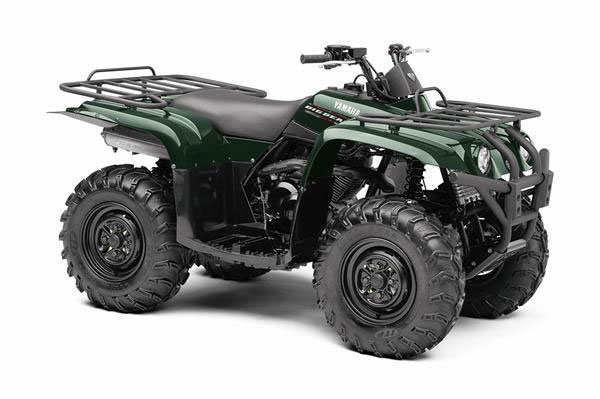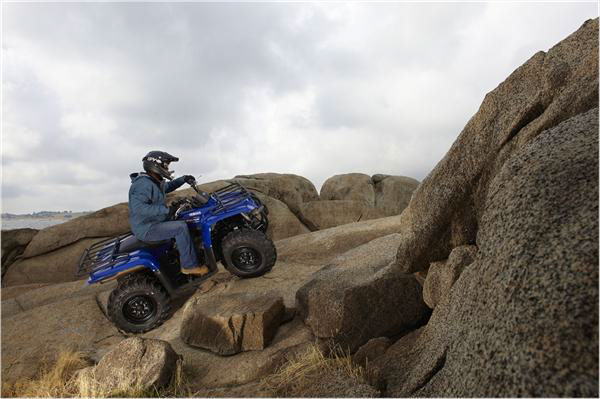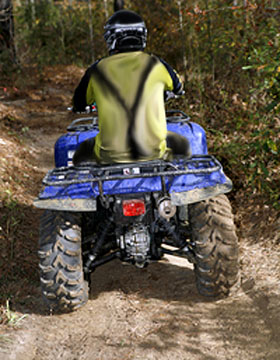ATV Review – 2011 Yamaha Big Bear 400

Old School in the Best Sense of the Term
by Jason Giacchino
Highs
Dependable
Versatile Transmission
Independent Suspension
Lows
Vibration
Engine Heat
Antiquated Chassis
Fact: Back in the day, when utility ATVs were the hot new thing and if you wanted a side x side experience you bought a golf cart, Yamaha’s flagship 4×4 (the Kodiak) was 400cc. People could be overheard at Yamaha dealers the world over saying things like, “400cc, why would anyone need so much power?”
These days 800 and even 1000cc multi-cylinder mills adorn stock ATVs and there’s a healthy aftermarket to accommodate those looking for even more juice. As for the 400s, they went from being the king of the hill to small-bore status in the utility ATV world. And yet, they’re still worth keeping around for their dependability, agility, and affordability. It may be a bit ironic that Yamaha has decided to keep the Big Bear moniker on a model that is becoming the smallest 4×4 on the line, but keep in mind that the nameplate dates back to a time when a 400 was considered over-the-top. Besides, would your buddies take you seriously if you showed up on a model called the Yamaha Small Bear? Or what about the Bear Cub?

Spec Action
Getting the power to the wheels is a tried and true carbureted 386cc air-cooled, single overhead cam, 2-valve single cylinder 4-stroke: Essentially a trip through time back to a simpler era. Until someone actually builds a flux-capacitor equipped DeLorean, this is as close to a time machine as you’re going to find.
Additional features include electric start with backup recoil, selectable 2WD/ 4WD with locking front differential, shaft drive, 5-speed transmission (automatic clutch) and analog instrumentation including a speedometer, odometer, fuel gauge, neutral, reverse and an oil temp indicator.
Start Me Up
Though technology has marched on, there is something to be said for the efficiency that a simple, proven package has to offer. Thanks to a handlebar-mounted choke lever, firing up the Big Bear is as simple as dialing in a little choke on the cold mornings and pressing the e-start button. There is undeniable comfort in knowing there’s a back-up pull starter, should the battery run down (though we never had to use it during our testing).
The Big Bear idles smoothly, and getting it to launch is merely a matter of stepping the left-side foot shifter into gear and getting on the gas. For many riders, especially those who remember the glory days mentioned above, the automatic clutch transmission was the perfect “in-between” a fully manual & fully automatic transmission. There are no concerns of having to ease out/operate a clutch, yet shifting through the 5-gears is entirely the operator’s responsibility. It offers a really nice sense of control and connection to the terrain. Riders who feel like automatic transmissions have taken too much interaction from the experience of ATV riding really ought to consider giving the automatic clutch ideal a go.

Riding Dirty
Even in 2WD, the Big Bear’s power delivery is grunty and favors torque over top speed/over-revving, however sometimes there comes a time when crossing a mud pit is inevitable. We were pleasantly surprised with how capable the machine’s 4WD system actually proved. So long as you managed to keep the mud/snow from catching the quad’s frame, it would claw its way through some seriously nasty conditions. It comes stock with beefy ITP Mud Lite tires that live for displacing water and muck. Only once were we able to hang the machine up bad enough to require activating the front differential lock. However once we locked it in, a little body English and a pegged throttle got the Big Bear right out of the trouble spot.
Suspended
Considering the dated nature of the Big Bear’s shock internals, we are pleased to report that it holds up quite favorably for most trail applications. Since the power spread is designed for fairly moderate speeds with abundant grunt on tap, the fairly stiff but responsive coil over shocks do a great job of soaking up trail debris and terrain.
Unlike many of the ATVs in its class, the Big Bear 400 offers up fully independent suspension/dual A-arms both front and rear (with swaybar out back). What results is an ATV that remains good and stable even over rocks, roots, logs and off-cambers.
The limitations of the fairly narrow chassis can rear their ugly head, should you start treating the Big Bear like a race machine. High speed, flat cornering does exhibit body roll. Factor in the reality that mud tires always give up bite in hard pack conditions and it becomes clear fairly quickly that Yamaha was wise to couple this package with an engine that favors technical exploration over top speed drag races.

Odds & Ends
Though we appreciate the Big Bear for its lack of technological intimidation, there are a few caveats that come with the formula. One of these is the presence of engine vibration that gets transmitted through the cockpit, especially in the top of each gear. It is by no means a threat to control, but things do feel a little buzzy when compared to the more refined nature of today’s crop of utility ATVs. Additionally the lack of thermostatically controlled liquid cooling results in heat that can be felt on the legs, especially on hot days at slow speeds. Get the engine wet once, she’s piping hot; prepare for a steam bath!
Braking is spectacular up front, thanks to dual hydraulic discs. The rear however is a bit touchier with a pair of manual (cable operated) disc brakes that can be made to lock up if application of the foot pedal isn’t done with care.
What the machine gives up to its more modern brethren on flat terrain it more than makes up for with stable, impressive climbing prowess and that automatic clutch transmission makes descending a dream (thanks to abundant engine breaking).
Conclusion
These are great days to be in the market for a utility ATV- there have literally never been more viable options from which to choose. You may hear riders waxing poetic about the good old days but don’t let anyone tell you having less options is a good thing. Today’s latest brood of liquid-cooled, dual overhead cam, 4-valve per cylinder, big-bore twins are incredibly capable specimens, but the manufacturers aren’t about to give up on the charm and dependability of the models of yesteryear.
The Big Bear 400 combines many of the traits we appreciated about ATVs a few years ago with a touch of today’s refinement. At ,599 (,949 for the camo scheme), the Big Bear is nearly half the cost of some of today’s flagship utility quads, and after a few weeks of taking it through northeastern trails that have been relentlessly pounded by rain, there aren’t a whole lot of places it can’t follow. In fact, under a seasoned rider with appreciation for how things worked a few years ago, it may even be able to lead.

Specs
Engine Type: 4-Stroke Single, Air/Oil Cooler w/ Fan, SOHC
Bore x Stroke: 83mm x 71.5mm
Compression Ratio: 8.6:1
Carburetion: Mikuni 33mm BSR
Ignition: DC – CDI
Starting System: Electric w/ Auxiliary Pull
Transmission: 5-Speed Automatic Clutch w/ Reverse
Drive Train: Yamaha On-Command push button 3-way locking differential 2WD, 4WD, Locked 4WD, Shaft Drive
Front Suspension: Independent Double Wishbone, 5.8” w/ 5-way Preload Adjustment Rear Suspension: Independent Double Wishbone, 7.6” w/ 5-way Preload Adjustment
Front Brakes: Dual Hydraulic Disc
Rear Brake: Fully Sealed, Oil Bath, Multi Disc
Front Tires: ITP Mud Lite 25×8-12
Rear Tires: ITP Mud Lite 25×10-12
Length/Width/Height: 79.4” x 43.9” x 46.7”
Seat Height: 35.2”
Wheelbase: 48.4”
Turing Radius: 126”
Ground Clearance: 10.5”
Fuel Capacity: 4.0 gal
Dry Weight: 593 lb
Rack Capacity: 88 lb Front / 176 lb Rear
Towing Capacity: 904 lb
Instrumentation: Speedometer / Odometer & Fuel Gauge
Lighting: Dual 30W Krypton Multi-reflector Headlights & 21/5W Brake light
Contact: http://www.yamaha-motor.com/
